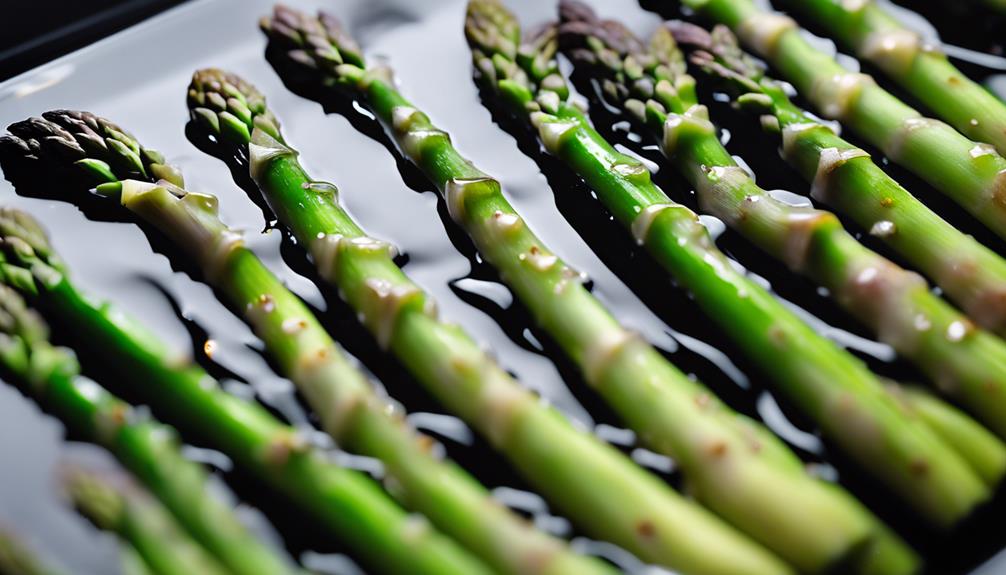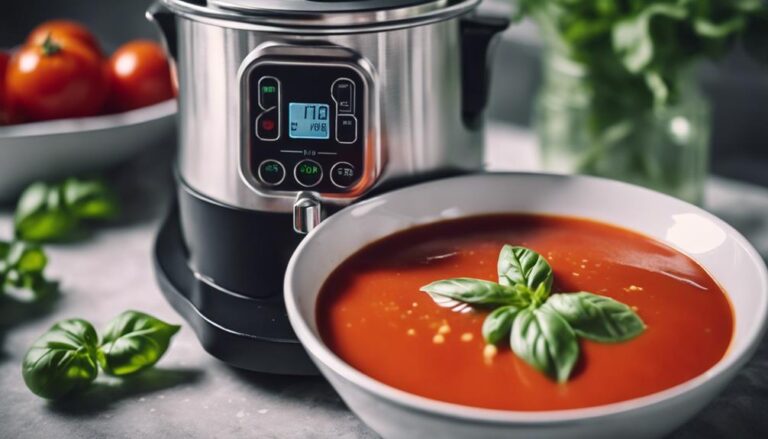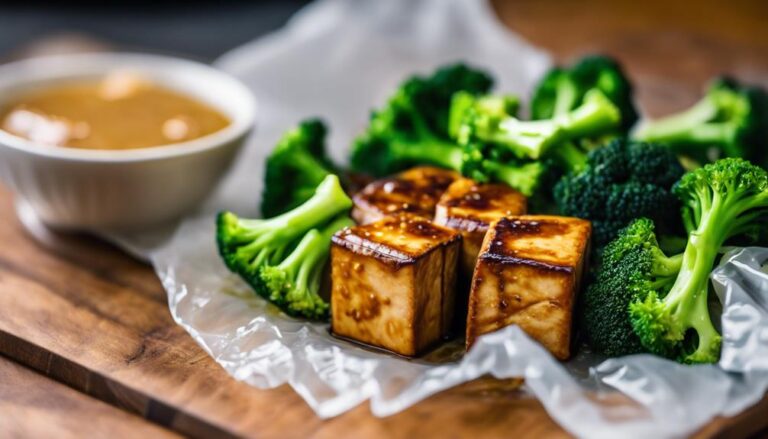Sous Vide Asparagus With Balsamic Reduction
Ready to take your asparagus to a whole new level? Sous vide asparagus with balsamic reduction is like sending this fancy veggie on a spa day. Seal in all that flavor and goodness by cooking it low and slow in a water bath, then drizzle that tangy balsamic reduction for an elevated taste experience. The sous vide method guarantees a perfect texture while keeping things deliciously tender. Want more tips on making your veggies sing? Stick around, and your taste buds will thank you!
What You Will Learn Here
- Sous vide ensures tender asparagus with precise cooking
- Balsamic reduction enhances asparagus' earthy flavors
- Optimal results with sous vide cooking technique
- Experiment with herbs and spices for customizing flavors
- Delicate flavors preserved, worth the extra time
Asparagus Cultivation Origins

So, you're curious about where those delicious asparagus spears you love so much come from?
Well, buckle up because we're about to take a trip back in time to uncover the roots of asparagus cultivation.
From ancient origins to the modern growth of this beloved vegetable, get ready to explore the fascinating history behind those tasty greens!
Asparagus Cultivation History
The cultivation history of asparagus can be traced back to ancient civilizations, where it was highly valued for its unique taste and health benefits. Ancient farmers were like culinary scientists, experimenting with different asparagus cultivation techniques to grow this veggie delight.
Asparagus held historical significance, being a favorite among the elite and even believed to have aphrodisiac powers (wink, wink). Imagine Cleopatra munching on some asparagus to woo Julius Caesar – talk about a power move! These early civilizations knew what was up when it came to cultivating and enjoying asparagus.
Ancient Asparagus Origins
Cultivating asparagus in ancient times required innovative techniques and a deep appreciation for its unique flavor and purported health benefits. Asparagus wasn't just a veggie; it was a symbol of luxury and fertility in ancient civilizations.
The ancient Greeks and Romans believed asparagus had some serious health perks, like being a natural aphrodisiac and kidney cleanser. Can you imagine the ancient folks munching on asparagus, hoping for a bit of romance and a good detox session? Talk about multitasking veggies!
With all these health benefits and symbolic meanings, it's no wonder asparagus has been cherished throughout the ages. So next time you're savoring a plate of asparagus, remember you're enjoying a veggie with a rich history and a lot of love!
Growth of Asparagus
Through innovative techniques and a deep appreciation for its unique flavor, ancient civilizations cultivated asparagus, viewing it as a symbol of luxury and fertility with purported health benefits. When it comes to asparagus, it's not just about the taste – this veggie is packed with nutrients like vitamins A, C, E, and K. Imagine those ancient farmers tending to their asparagus patches, knowing they were not just planting a vegetable but a powerhouse of nutrition. Asparagus also has its seasons; it's a spring delicacy, so enjoy it while you can during those months. Check out the table below for a quick overview of asparagus nutrition and its seasonal availability.
| Nutrient | Amount |
|---|---|
| Vitamin A | High |
| Vitamin C | High |
| Vitamin E | Moderate |
| Vitamin K | High |
Fresh Asparagus Selection

When selecting fresh asparagus, look for firm stalks with tightly closed tips. You want those vibrant green spears that are crisp and full of flavor.
Here are a few tips to help you pick the best asparagus:
- Thickness Matters: Thicker asparagus spears tend to be meatier and great for roasting or grilling. Thinner spears are more delicate and cook quickly, perfect for salads or quick sautés.
- Check the Tips: The asparagus tips should be tightly closed and compact. Avoid any bunches with wilted or mushy tips as they indicate the asparagus is past its prime.
- Color Confidence: Look for asparagus with a consistent green color from top to bottom. Avoid any yellowing or white discoloration, as it can be a sign of aging or improper storage.
Asparagus-Based Dishes
So, you've mastered the art of sous vide asparagus with a balsamic reduction, but have you tried taking your asparagus game up a notch?
Think beyond the basics and explore the world of asparagus-based dishes like balsamic-infused spears or delightful asparagus roll-ups drizzled with that sweet balsamic goodness.
Get ready to elevate your veggie game and impress your taste buds with these creative asparagus creations!
Sous Vide Asparagus: Balsamic Infusion
To enhance the flavor profile of sous vide asparagus, consider infusing it with a balsamic reduction for a delightful twist on this classic dish. Imagine the tender asparagus spears soaking up the rich and tangy balsamic goodness—it's like a flavor explosion in your mouth!
Here are a few ways this flavor infusion can take your dish to the next level:
- Intensified Taste: The balsamic reduction adds depth and complexity to the asparagus, elevating its natural flavors.
- Caramelized Sweetness: The balsamic reduction's sweetness enhances the asparagus's earthy notes, creating a perfect balance of flavors.
- Glossy Finish: The balsamic glaze gives the asparagus a beautiful shiny coating, making it not only delicious but also visually appealing.
Give it a try and watch your taste buds do a happy dance!
Balsamic-Glazed Asparagus Spears
Enhance your asparagus-based dishes with the delectable touch of balsamic-glazed asparagus spears. These spears offer a burst of flavor that will elevate your culinary game to new heights.
Here are some ideas to take your dish to the next level:
- Balsamic Pairing Ideas:
- Try pairing the balsamic-glazed asparagus spears with creamy goat cheese for a delightful contrast of flavors.
- For an invigorating twist, serve the spears alongside juicy cherry tomatoes drizzled with balsamic reduction.
- Sous Vide Presentation Ideas:
- Serve the asparagus spears on a sleek white platter for a modern and elegant presentation.
- Garnish the dish with a sprinkle of toasted almonds to add a delightful crunch.
These simple additions will make your balsamic-glazed asparagus spears a standout dish at any gathering!
Balsamic Asparagus Roll-Ups
For an elegant and flavorful appetizer, try making balsamic asparagus roll-ups using fresh asparagus spears and balsamic reduction. These roll-ups aren't only delicious but also make for creative presentations that will impress your guests.
Here's how to make them:
- Select Your Spears: Choose fresh asparagus spears with vibrant green tips for the best flavor.
- Roll It Up: Wrap each asparagus spear in a thin slice of prosciutto or your favorite deli meat for a savory twist.
- Drizzle and Serve: Finish off your roll-ups by drizzling them with a generous amount of balsamic reduction for a burst of tangy sweetness.
These flavorful appetizers are perfect for any gathering, adding a touch of sophistication to your spread!
Asparagus Blanching Technique
So, you want your asparagus to be just right – not too crunchy, not too mushy.
Well, the key lies in the blanching technique. Get that water temperature spot on, watch the clock for perfect timing, and don't forget the ice bath to cool things down.
Water Temperature for Blanching
Setting the water temperature precisely is crucial for blanching asparagus to maintain its vibrant color and crisp texture. The ideal temperature for blanching asparagus is around 185°F (85°C). This temperature allows the asparagus to cook quickly without becoming mushy or losing its bright green hue.
When you're heating the water, think of it as creating a cozy Jacuzzi for your asparagus – not too hot to scald, but warm enough to relax and rejuvenate.
Once you have the water at the perfect temperature, it's time to plunge those lovely green spears in for a quick dip. Remember, you want them to be tender but still have a bit of crunch when you bite into them. So, keep that water temperature steady for asparagus excellence!
Timing for Perfect Blanching
Maintain the vibrant color and crisp texture of your asparagus by mastering the perfect timing for blanching.
When it comes to blanching asparagus, timing is everything! Get your water temperature to a gentle simmer, not a raging boil – we're pampering asparagus, not sending it to a hot tub party.
Once the water is just right, plunge those green beauties in for about 2-3 minutes. It's like giving them a quick wake-up call before they chill out. Remember, we want them to be bright and slightly tender, not mushy and sad.
Ice Bath for Cooling
To chill your perfectly blanched asparagus efficiently, immediately transfer them to an ice bath. This step halts the cooking process, preserving that lovely crunch and vibrant green color. The ice bath serves as a rejuvenating dip in a chilly pool on a hot summer day for your veggies! Here's a nifty table to showcase different cooling techniques and their impact on flavor infusion:
| Cooling Technique | Flavor Infusion |
|---|---|
| Ice Bath | Preserves freshness |
| Shock Cooling | Enhances color retention |
| Room Temperature | Gradual flavor development |
| Refrigeration | Delays flavor changes |
Final Thoughts
As you reflect on the sous vide asparagus with balsamic reduction, consider how the delicate flavors and perfectly tender texture elevate this classic dish to a new level of culinary excellence. The sous vide benefits truly shine through, ensuring that each stalk of asparagus is cooked to perfection, retaining all its natural goodness. However, let's not forget the limitations – sous vide might take a bit longer, but trust me, the end result is worth the extra time!
When it comes to flavor pairing tips and tricks, think outside the box! Balsamic reduction adds that tangy sweetness that complements the earthiness of asparagus flawlessly. Don't be afraid to experiment with different herbs and spices to suit your taste buds – after all, cooking is all about having fun in the kitchen.
Frequently Asked Questions
Can I Use Frozen Asparagus for This Recipe?
Yes, you can use frozen asparagus for this recipe. Just make sure to adjust the cooking time accordingly when using different cooking techniques. Fresh vs. frozen produce can impact the final result, so adapt as needed.
How Long Can I Store Balsamic Reduction?
You can store balsamic reduction for a few months in the fridge for best quality. Properly sealed in an airtight container, it can maintain its flavor for an extended period. Check for any signs of spoilage before use.
Is It Safe to Reuse Sous Vide Bags?
When reusing sous vide bags, be cautious. Check for any damage or wear that could compromise safety. Proper cleaning and sanitizing are essential to prevent health risks. Consider the environmental impact of bag reusability.
Can I Substitute Balsamic Vinegar With Other Ingredients?
When it comes to balsamic vinegar substitutes, you have options like red wine vinegar, apple cider vinegar, or a mix of honey and soy sauce. Experiment to find what suits your taste preferences and cooking variations best.
How Do I Know When Asparagus Is Overcooked?
To know when asparagus is overcooked, perform a texture test. It should be tender yet slightly crisp. Visual cues include a dull color and limp appearance. Trust your taste preference; overcooked asparagus loses flavor and becomes mushy.
Conclusion
So there you have it, folks! Sous vide asparagus with balsamic reduction may sound fancy, but it's actually a super easy way to elevate your veggie game.
Just a little bit of prep, a sprinkle of seasoning, and voilà – you've got yourself a delicious and nutritious dish that will impress your taste buds and your friends.
So go ahead, give it a try and enjoy the tender, flavorful goodness of sous vide asparagus!











